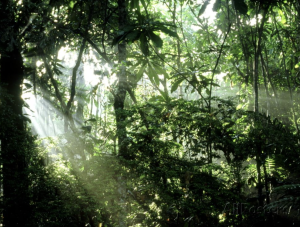Panama, a land bridging North and South America, is renowned for its diverse landscapes and rich biodiversity. Rainforests in Panama stand out as emerald jewels that blanket significant portions of the country, and a big draw for both ecotourism and international researchers. In this blog exploration, we delve into the enchanting realm of rainforests in Panama, discovering their unique features, ecological significance, and the efforts undertaken for their conservation.
The Biodiversity Extravaganza: A Closer Look at Panama’s Rainforests
Panama’s rainforests boast an astonishing array of flora and fauna, making them a hotspot for biodiversity enthusiasts and scientists alike. The dense canopies, teeming with life, host an estimated 1,500 species of trees and over 940 species of birds. Jaguars, ocelots, and various species of monkeys swing from branch to branch, creating a lively and dynamic ecosystem.
One of the key reasons behind this incredible biodiversity is Panama’s geographical location. Positioned as a land bridge between North and South America, it serves as a thoroughfare for various species, fostering a mix of unique flora and fauna from both continents. As a result, the rainforests in Panama act as living museums of evolutionary history, showcasing the interconnectedness of diverse ecosystems.
The Canopy Tower in Soberanía National Park provides a spectacular vantage point for bird enthusiasts. From this elevated perch, visitors can witness the vibrant plumage of toucans, parrots, and hummingbirds against the backdrop of a lush, green sea of treetops. Exploring the depths of Panama’s rainforests reveals a treasure trove of medicinal plants, orchids, and other endemic species, each contributing to the complex tapestry of life in this unique ecosystem.
Threats to Paradise: Challenges Facing Rainforests in Panama
While Panama’s rainforests are undeniably breathtaking, they face numerous threats that jeopardize their delicate balance. Deforestation, driven by logging, agriculture, and infrastructure development, poses a severe risk to these ecosystems. The expansion of roads and urban areas into pristine rainforest territories not only fragments habitats but also opens the door to illegal activities such as poaching and logging.
Climate change further exacerbates the challenges faced by Panama’s rainforests. Alterations in precipitation patterns, rising temperatures, and extreme weather events can disrupt the finely tuned balance that sustains this delicate ecosystem. Additionally, the spread of infectious diseases, intensified by climate change, poses a threat to both plants and animals within the rainforests.
Conservation organizations and the Panamanian government have recognized the urgency of addressing these challenges. Initiatives like the Mesoamerican Biological Corridor aim to create interconnected habitats that facilitate the movement of wildlife and promote genetic diversity. Protected areas, such as Darien National Park, play a crucial role in safeguarding the biodiversity of the rainforests by providing refuge for endangered species and serving as research and monitoring sites.
Indigenous Wisdom: Harmony Between Communities and Rainforests
The indigenous communities inhabiting the rainforest regions of Panama have long been stewards of these precious ecosystems. Their traditional knowledge and sustainable practices have allowed them to coexist harmoniously with nature for generations. From the Ngäbe-Buglé to the Emberá-Wounaan, these communities hold a deep respect for the rainforest, viewing it not just as a resource but as a living entity deserving of protection.
Sustainable harvesting techniques, such as agroforestry and selective logging, are integral to the indigenous approach to resource utilization. These practices ensure that the rainforest continues to thrive, providing for the needs of the community without causing irreversible harm. Recognizing the value of indigenous wisdom, conservation efforts in Panama increasingly involve collaboration with local communities to create effective and sustainable strategies for preserving the rainforests.
Ecotourism: Nurturing Conservation Through Responsible Exploration
As awareness of the importance of rainforest conservation grows, ecotourism has emerged as a powerful tool for promoting sustainability and supporting local communities. Panama’s rainforests offer a plethora of opportunities for eco-conscious travelers to engage with nature responsibly. Guided tours, birdwatching expeditions, and canopy walks not only provide an immersive experience but also contribute to the financial well-being of local communities.
Ecotourism fosters a sense of appreciation and responsibility among visitors, encouraging them to become advocates for rainforest conservation. Revenue generated from sustainable tourism initiatives can be channeled into conservation projects, creating a cycle of positive impact. Moreover, by showcasing the intrinsic value of these ecosystems, ecotourism helps build a global community committed to the preservation of rainforests not only in Panama but across the world.
A Call to Protect Panama’s Rainforest Heritage
Panama’s rainforests, with their unparalleled biodiversity and ecological significance, stand as irreplaceable treasures that warrant our protection. As we marvel at the vibrant life within these lush landscapes, it becomes our responsibility to address the threats that loom over them. By supporting conservation initiatives, respecting indigenous knowledge, and embracing sustainable practices, we can ensure that the rainforests in Panama continue to thrive for generations to come. Let us join hands in preserving these natural wonders, recognizing that the fate of the rainforests is intertwined with the well-being of our planet. To learn more about rainforests in Panama and how to see them up close, contact us here.
